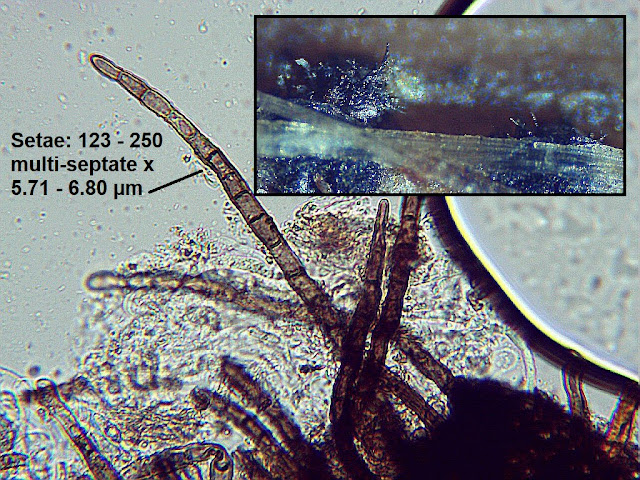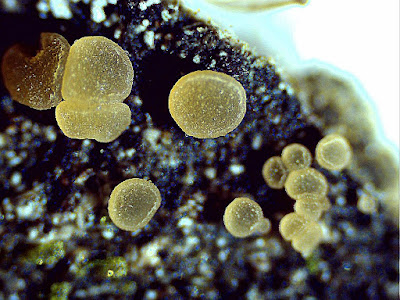I'll start with my most recent trip which took me to Devon and Offwell Woods, located just south of Honiton. Here I found a delightful habitat of two interconnecting streams creating a mossy damp local climate which tends to attract all sorts of fungi. Here was no different as when I was about to depart I noticed a large white vertical wall of a polypore type resupinate growing inside a cracked stump which I assumed to be Pinus, as I know the woodland is predominantly of this species. After examination at home this became Antrodia carbonica, only the 4th record for the UK after being first found by Prof. Fortrey in 2011. Mostly found in the USA, the key here was the flesh or context turns very quickly blue/black with Melzters staining, along with amyloid walls to the skeletal hyphae and the spores remaining neutral. The spores were accurate also and I was able to obtain a spore print. I would send this type of record for sequencing but finding a reliable source these days that won't take six-months to check, if at all, is very difficult. You can pay of course and normally overseas as it appears the amateur mycologist always goes to the back of the queue. Sad, but this is the way at the moment yet to me this is where most new species are found as we are constantly looking whereas many of the professionals tend to revaluate old records, re-sequence and move taxonomy around. Has to be done, but the foot soldiers don't get supported as well as they should - In my opinion!!
Others this month included myxomycete Badhamia foliicola on Pyrus (new to Gloucs.), Camarops polysperma on Fagus at Ebworth NT Estate (also new) and the best of all an agaric still fruiting in the middle of January in a damp marshy area near Frampton-on-Severn by an Oak plantation. This had lost most of its colouration, but the remaining macro and micro details, included odour told me this was Dermoloma pseudocuneifolum (again new to Gloucs.). At woods east of Duntisbourne I found a large ancient Ilex (Holly) tree and so spent some time around this tree as expected something different from this unusual lovely specimen. Firstly I found Diaporthe crustosa, a plain and simple ascomycete and then a jelly type fungus on a detached branch hidden within the tree itself containing Exidiopsis opalea (new for Gloucs. and well beyond). At Cirencester Park I found the uncommon Hypochnicium bombycinum on Abies alba as well as the rarer Trechispora dimitica with its tiny spiny cut away spores (New for Gloucs.). Also here was my second finding of a new species for the UK I found two years ago thanks to the ID of Paul Cannon (Kew) now called Schizoxylon sp. 4600! The string shaped spores are much smaller than all other known species of this genus. On Abies alba this time. My first visit to the nearby NT site at Crickley Hill near Birdlip on a wet and misty day still produced Karstemia rhopaloides on Blackthorn followed by a visit back to Ebworth NT where I found the tiny almost invisible clustering Merismodes anomalus on Quercus near a stream as well as the Pyrenochaeta fallax ascomycete (new for Gloucs and all Sth West also). Back at the woodland near Duntisbourne but this time on Pinus, I located the Jelly fungus Phaeotrella frondosa and close by as as expected also on rotting Pinus was Tubulicrinus subulatus. Seen before but uncommon all the same. Most grey almost non-existent 'fluffy' resupinates on rotting branches of Pinus are of this family, so worth taking a look as they possess incredible Lypocystidia which are unlike most. So considering we had a cold spell with snow during this month, fungus is alive and well in winter if you keep on looking. Luck helps also!
On the last day of January, I also found an uncommon resupinate in Athelopsis glaucina, helped by thin allantoid spores in Cirencester Park once again. New to Gloucs.
 |
| Antrodia carbonica |
 |
| Antrodia carbonica blue/bck in Meltzers |
 |
| Antrodia carbonica on Pinus |
 |
| Antrodia carbonica spores |
 |
| Badhamia foliicola |
 |
| Camarops polysperma |
 |
| Dermoloma pseudocuneifolum under Oak |
 |
| Diaporthe crustosa |
 |
| Exidiopsis opalea |
 |
| Karstemia rhopaloides ascospores |
 |
| Karstemia rhopaloides |
 |
| Merismodes anomalus |
 |
| Merismodes anomalus x40 |
 |
| Phaeotremella frondosa |
 |
| Pyrenochaeta fallax |
%20ref%20KEW%20x40%2006.01.23%20-%20Copy.jpg) |
| Schizoxylon sp 4600 (Kew) |
 |
| Trechispora dimitica |
 |
| Trechispora dimitica spores |
 |
| Tubulicrinus subulatus Lypocystidia |
 |
| Athelopsis glaucina spores |
 |
| Athelopsis glaucina |
 |
Tubulicrinus subulatus
|















%20ref%20KEW%20x40%2006.01.23%20-%20Copy.jpg)





















